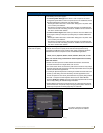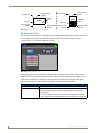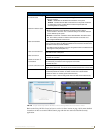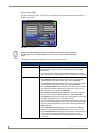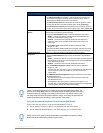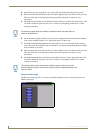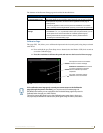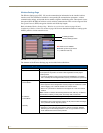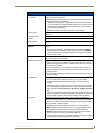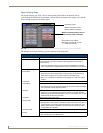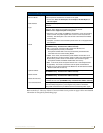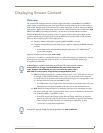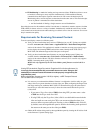
Firmware Pages and Descriptions
163
VG-Series Modero Touch Panels
Wireless Settings Page Elements (Cont.)
IP Settings (Cont.):
Host Name Sets the host name of the panel.
• PRIMARY DNS sets the address of the primary DNS server being used by the
Modero panel for host name lookups.
- DNS (Domain Name System) is software that lets users locate computers
on a local network or the Internet (TCP/IP network) by host and domain. The
DNS server maintains a database of host names for its’ domain and their
corresponding IP Addresses.
• SECONDARY DNS sets the secondary DNS value to the panel.
Primary DNS Sets the address of the primary DNS server used by the panel for host name
lookups.
Secondary DNS Sets the secondary DNS value to the Modero panel.
Domain Sets the unique name on the Internet to the panel for DNS look-up.
MAC Address This value is factory set by the manufacturer of the wireless mini-PCI Ethernet
card.
Access Point MAC
Address:
This value is factory set by the manufacturer of the Wireless Access Point
(WAP).
• When communicating with a WAP200G enter the MAC Address (BSSID) of
the target WAP as the Access Point MAC Address. Refer to the WAP200G
Instruction Manual for more detailed information on the interaction between
these two product lines.
Wireless Settings: Sets the communication values for the optional NXA-PCI80211G mini-PCI wire-
less communication card (if present).
Network Name (SSID) Provides the Service Set Identifier (SSID), required by the panel, before it is
permitted to join the wireless network. The SSID is the unique name used on
the WAP and assigned to all panels in a wireless network that are communicat-
ing to the same target WAP.
• It is case sensitive and must not exceed 32 characters, which may be any
keyboard character. Make sure this setting is the same for all points in your
wireless network.
• This unique string identifies the network and is the same string for all users on
the same network.
Authentication Toggles between the two authentication modes: Open System or Shared Key:
•An Open system network allows connections from any client without
authenticating whether that client has permission to associate with the
network.
•A Shared key network requires the client to submit a key which is shared by
the network Wireless Access Point before it is given permission to associate
with the network. In this case the key is the same as the WEP encryption
key.
• In both cases, even after association has taken place, if WEP encryption has
also been enabled then the client will still require the WEP key to encrypt and
decrypt packets in order to communicate successfully with the network.
Encryption Cycles through the available encryption options: Clear Text, WEP64, and
WEP128. Wired Equivalent Privacy is an 802.11 security protocol for wireless
networks. The WEP encryption method is designed to provide the "equivalent"
security available in wireline networks.
• Clear Text causes network packets to be sent out as unencrypted text.
• WEP64 enables WEP encryption at 64-bits. In this case all packets will be
transmitted with their contents encrypted using the Default WEP Key.
• WEP128 enables WEP encryption at 128-bits. All packets are transmitted
with their contents encrypted using the Default WEP Key.
• If the key is not the correct size, the system will resize it to match the number
of bits required for the WEP encryption mode selected.



